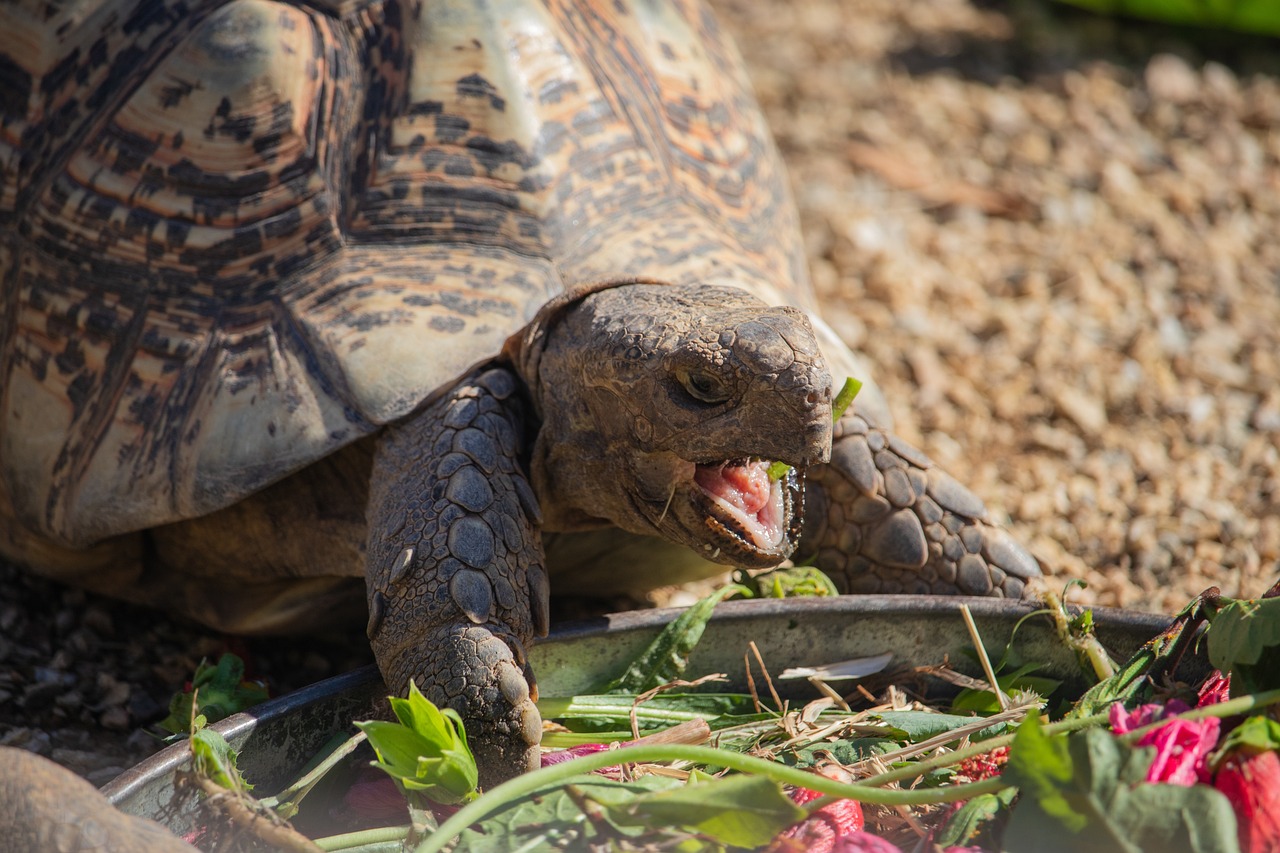Tortoises and lizards come from all over the world and, as such, their diets vary from species to species. You should confirm what species your tortoise or lizard is before carefully researching a suitable diet for them. We are able to help you with this so please contact us if you are unsure.
Commercial diets
Commercial diets are not recommended for tortoises and lizards, as many are too high in protein and do not take into account specific species requirements. We recommend sticking to a diet close to what your pet would eat in the wild. For most commonly kept species of tortoise; this will be predominantly weeds and other plants. Some species of less commonly-kept tortoises and many herbivorous lizards can also eat fruit.
Commonly kept species of tortoise
Horsfields (also known as Russian Tortoises), Hermann’s, Spur Thighed and Marginated tortoises
These tortoises are completely herbivorous and require a low protein diet. Contrary to old fashioned myths, they should never be fed dog or cat food. You should also avoid feeding them high protein vegetables, such as peas and beans. Diets high in protein can cause kidney diseases in these species.
In the wild, these species would rarely come across fruit so should only rarely be fed this as a treat or to help them accept medication, as the high sugar content can upset their digestive system.
Weeds and plants
By far the best diet for most Mediterranean or desert species of tortoise is a plant based diet. Variety is the key, as no single type of plant or weed will provide all of the nutrition your tortoise needs. We recommend planting some tortoise friendly plants in your garden, and saving a section of the garden where tortoise-friendly weeds can grow.
Ensure that any plants or flowers grown for your tortoise are not treated with any pesticides, fertilisers or other chemicals that may be harmful to your tortoise.
Safe commonly growing weeds
- Grass (wheat, barley and timothy)
- Dandelion (including flowers)Hawkbit
- Hawk’s Beard
- Plantains
- Thistles – including sowthistle, glow thistle and scotch thistle
- Dead Nettle (young stinging nettle leaves can also be fed in moderation)
- Clover (in moderation)
- Young bramble leaves (in moderation)
- Bindweed (in moderation)
- Chickweed (in moderation)
Commonly grown safe plants and flowers
- Pansies, violets and violas
- Forget-me-nots
- Geraniums
- Campanula
- Antirrhinum
- Mimulus
Lettuce and salad
Whilst most types of lettuce and other salads leaves are safe to feed, salad leaves alone do not meet the nutritional or fibre requirements for tortoises and should only form a small part of the diet. Packaged cut lettuce will lose some of its nutritional value, so it is best to buy the whole lettuce or grow your own. A tortoise fed on lettuce alone will not thrive and may suffer from long-term health problems.
Other shop bought food – these should only be fed in small amounts
- Rocket
- Pak Choi
- Kale
- Cress
- Watercress
- Grated carrot
- Cucumber
- Basil
- Thyme
Other species of tortoise
Red footed tortoises and yellow footed tortoises are tropical species and are the most commonly kept fruit-eating species of tortoise. The bulk of their diet should consist of many of the plants listed above, but they should also enjoy a wide variety of fruits and vegetables, which should form around 15% of their diet. These tortoises will also eat carrion in the wild, and so a small amount of animal protein such as low fat rehydrated dry dog food can be offered every 1-2weeks.
Safe fruit and vegetables for fruit-eating species
- Papaya
- Mango
- Strawberries
- Bananas
- Berries
- Courgette
- Squash
- Bell Peppers
Herbivorous Lizards
Herbivorous lizards such as green iguanas can enjoy many of the foods listed above – most food that is safe for tortoises is also safe for other herbiovous reptiles. Their diet should predominantly be made up of dark leafy greens, with chopped or grated vegetables (such as courgette, squash, carrot and sweet potato). Fruits such as papaya, mango, strawberries and bananas should form around 5% of their diet.
UV lighting and Calcium
Broad spectrum UV lighting is essential to most reptiles, particularly diurnal species such as Mediterranean and desert tortoises. In the warmer months, UVB is best obtained through spending time outdoors in the sunshine– please note that a glass window will block the UVB part of sunlight, so indoor tortoise enclosures should have a UVB lamp attached that is suitable for desert species. Reptiles use UVB by converting Vitamin D into Vitamin D3, which then aids the absorption of calcium- without UVB, they are simply unable to absorb calcium, even if the rest of their diet is perfect. Calcium plays a vital role in nerve and muscle function, as well as preventing metabolic bone disease. It is important that you provide a calcium supplement. We recommend Nutrobal as a good, all-round supplement for tortoises.
Water
Most tortoises are unable to drink from a shallow water bowl, so we recommend they have access to a large water bowl or tray that is big enough for them to climb completely into to drink. The water should be deep enough to come up to the skirt of their plastron, but should be shallow enough for them to be able to lift their head out of the water. Tortoises are able to consume water through their cloaca and their bladder – so don’t be alarmed if they appear to just sit there! Some will also submerge their head under the water to drink.
Warm baths should be offered a minimum of twice a week for 15-20minutes. Ideally, these baths can be given every day if you can- this will help to keep your tortoise hydrated and help them to eliminate urates and faeces.


